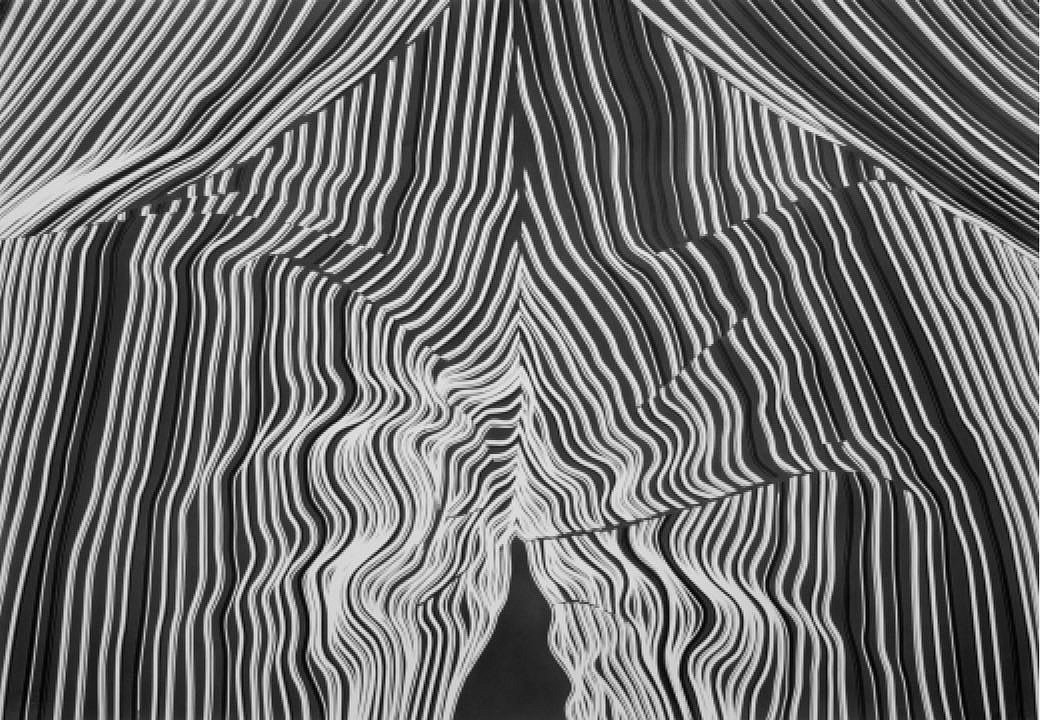In the work of British artist Fiona Banner (Merseyside, 1966), opposites play a significant role. This concerns the relationship between words and images, man and machines, but also between the physical world and the virtual one. Her work comprises sculpture, drawings, video installations, performances, posters and books. The exhibition is Banner’s first major presentation in the Netherlands.
In the vast industrial space of De Pont’s main gallery, Banner creates a theatrical mise-en-scène where towering helicopter rotor blades and re-purposed military plane parts become the unknowing cast. Her deft handling of these objects reveals their anthropomorphic potential: Gazelle helicopter rotor blades are reminiscent of totem poles; a pair of Harrier nose cones suggest breasts, and elsewhere faces emerge from the juxtaposition of Jaguar drop tanks with abstract graphite drawings of full stops in different typefaces. Banner has long been fascinated by military aircraft, finding them at once beautiful and horrifying; almost ‘prehistoric, from a time before words’.
This relationship to language and conflict underpins much of her work. For Banner, the ever rotating criss-cross of blades as they mark out time and space is like a language trying to happen or a text trying to be formulated, ‘It’s like they are trying to spell out something that can’t be said.’ The exhibition’s title Runway (AW17), refers to a runway as a space of performance, evoking the architecture of fashion shows, as well as a space associated with aircraft. By deploying the double meaning she draws parallels between the haiku theatre of a catwalk show and the theatre of the exhibition space. From an adjoining space the noise of a drone melded with a tribal drumbeat can be heard.
The video installation Phantom (SS16) reveals only the shadow of the Drone Phantom camera as it aims its lens at a magazine. The pages flutter about and the publication is chased as the helicopter’s propellers stir up wind on its approach. This drone’s mission is doomed to failure; the magazine remains unreadable. Protruding from both sides of the projection screen is a long raised platform, evoking the drama of fashion shows. In this case the catwalk is host to a graphite drawing where pinstripe patterning morphs into runway markings, a possible stage for the cast of characters seen in the main space. The prey being hunted down by the hawk-like Phantom is Banner’s recent publication Heart of Darkness, an illustrated reprint of Joseph Conrad’s 1899 novella. Conrad’s tale is a story of trade and corruption, and of our own conflicts and desires. From a boat moored on the banks of the River Thames in London, the protagonist Marlow narrates his story in which he travels to the heart of the Congo in search of renegade ivory trader Kurtz, who has mesmerized and enslaved his workers.
Banner’s reprint takes the form of a glossy fashion magazine. Its text is paired with images of the City of London that Banner commissioned from Magnum conflict photographer Paolo Pellegrin, having asked him to photograph this global financial center as a conflict zone. The book also contains Banner’s drawings depicting close-ups of pinstripe, a play on the livery and camouflage of the Square Mile. The same motif surfaces again on two nose cones from Harrier fighter jets. The title of this work, which is part of De Pont’s collection, Nose Art (2015), alludes to the aviators’ old custom of painting popular icons or pin-ups on their fighter planes.
Banners work is characterized, as she once said, by a ‘dysfunctional relationship with the image.’ That began early on, when she came to a dead-end while painting images from Hollywood films such as Top Gun while at Goldsmiths College in London. She attempted to circumvent the problem by describing in words the images and movie narratives. These texts often took the form of ‘wordscapes’: films that she verbally transcribed, often making vast cinemascope drawings. On being nominated for the Turner Prize in 2002, her controversial contribution to the show consisted of a description of the porn film Arsewoman in Wonderland. In De Pont’s collection, the sculpture Work 1, a life-sized scaffold tower made entirely of glass, embodies a fragile recollection of installing such oversized wall pieces.
Banner’s relationship between the virtual and the physical is ever-present. She has often described words as her medium. She combined existing typefaces that she had used a lot in her work to create new typeface called Font, which anyone can download for free (www.fionabanner.com). Gruesome images from war movies and porn films appeal to the same primitive instincts. War arises when communication and words fail. Runway (aw17) exudes an atmosphere of imminent invasion, similar to the climate now gripping European politics, but there is also something playful about it. Connotations of words and artworks change. They are not carved in stone. ‘The work is un-static’, says Banner, ‘and that’s what really interests me about being an artist.’
Watch this video about Fiona Banner's exhibition.
